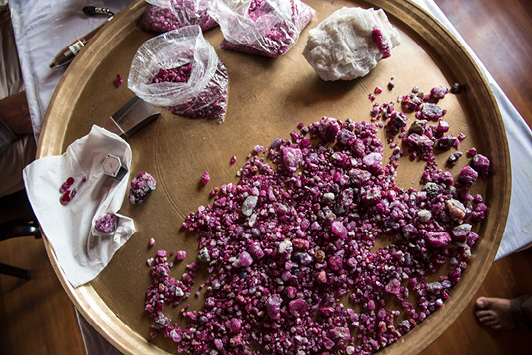
Even with the explosion of colored gemstones in the jewelry market over the past 20 years, the Big Three — ruby, emerald and sapphire — have managed to stay on top. Ruby is rarer than sapphire and reigns over its Big Three brethren as auction house champion. But its rarity makes it more an investment than a trend, with prices as stable as the Swiss franc.
Evidence of this abounds at auction sales. Last year, Sotheby’s sold a 24.70-carat ruby ring for just over $11 million, as well as an 8.11-carat ruby ring for $2.8 million and a Cartier ruby and diamond brooch for just over $1 million. Christie’s has reported similar results, often with Burmese specimens that, like the Hope Diamond, are important enough to have names: The 15.04-carat Crimson Flame, which netted $18 million in 2015, and the 15.99-carat Jubilee, which fetched nearly $14.2 million as the center of a Verdura ring the following year, are prime examples.
Other Burmese ruby pieces Christie’s has sold in recent years include a Cartier brooch with a 10-carat ruby for $8.2 million and a Faidee ring with a 10.05-carat stone that brought in just over $10 million. The list goes on, with Christie’s top lots hovering around $1 million per carat.
Calling for pigeon blood
These sales are among the many that prove origin is still of major significance when it comes to ruby. Burmese implies pigeon blood red — a particularly valuable color for investment.
“We have seen exceptional prices in recent years,” says Daphne Lingon, Christie’s head of jewelry for the Americas. “Gems over 5 carats, and in particular, gems that have not undergone any enhancement, are extremely rare. This is largely due to the fact that the famous Mogok mines [in Burma] are yielding fewer and fewer stones of an important size.”
That means a dwindling number of pieces available to be consigned at auction, which leads to more demand.
“The pieces we do offer perform exceptionally well,” says Lingon, “from single-stone offerings to vintage designs that incorporate quality rubies, as seen with the Raymond Yard Art Deco piece we just sold.” Two pieces by Raymond Yard, circa 1925, sold respectively for $106,250 and $75,000 at the Christie’s New York sale in April — over three times their estimates.
Burmese quality, Mozambique quantity
“Getting ruby is not a major problem yet,” says Navneet Agarwal of Navneet Gems, a Thai dealer actively selling wholesale in the US market. “For a couple of years, we have seen a lot of Mozambique ruby taking over the market, since [UK-based miner] Gemfields took over all of Mozambique’s ruby supply.”
Agarwal says the best gems are still coming from Burma,
now known as Myanmar.
“The US lifted its ban on Burmese gems [in 2016], so it’s legal to import them now, and demand has gone up quite a lot. Maybe 30% or so,” he notes. Nonetheless, he says, “most material is coming from Mozambique.”
Niveet Nagpal, president of Omi Gems in Los Angeles, California, concurs that Mozambique production is the reason there are generally “more rubies on the market today than there have been in quite some time.”
But, he continues, “a majority of the rubies from this area are of commercial quality; fine-quality rubies, especially in larger sizes (over 3 carats) are still quite rare.”
There’s very little production of the high-quality Burmese stones, Nagpal notes, adding that “there are some very fine 5-carat-plus rubies from Mozambique on the market, and there are some areas in [Mozambique mining site] Montepuez that produce rubies with very little iron (iron causes rubies to be darker and a less-intense red). Once these areas are mined out, prices should increase significantly.”
Jewelry in the making
While supplies of fine ruby last, it is comforting to know that the big brands are still producing important works that will serve as the heirlooms and auction darlings of the future, keeping the stone’s value high. And so far, there is nothing
like a highly saturated ruby to add clout to a well-made piece of jewelry.
As in the past, invisible setting is still the ultimate way to show off the gem’s color. Van Cleef & Arpels, famous for its mastery of this setting technique, is still making masterpieces with it in both modern and antique styles.
And this year at Baselworld, Chopard introduced its Magical Setting collection of ruby cluster rings, pendants and earrings, using a new technique exclusive to Chopard that holds the gems from underneath, with no metal showing in the cluster.
Even if you’re not in it for the investment value, though, there are other reasons to love ruby. It symbolizes luxury and is said to protect its wearer from misfortune and bad health. It is also the traditional gemstone of a couple’s 40th anniversary.
Italian jeweler Roberto Coin signs each one of his pieces by setting a small ruby inside the jewel. There is a belief that when a ruby comes into direct contact with the skin of the wearer, it guarantees love, joy and everlasting health. “This magical signature, surrounded by an antique halo of legend, represents a message of good wishes,” says Coin.
Alas, laments the Vicenza-based jeweler, who makes everything from everyday classic jewelry to Red Carpet collections, “rubies can never become a real trend in jewelry, because they are too rare.”
Image: Thierry Falise/LightRocket;Getty
Article from the Rapaport Magazine - June 2019. To subscribe click here.